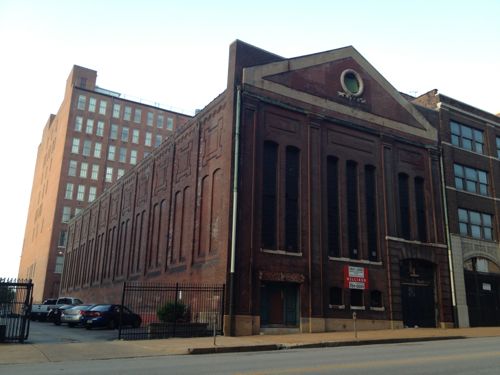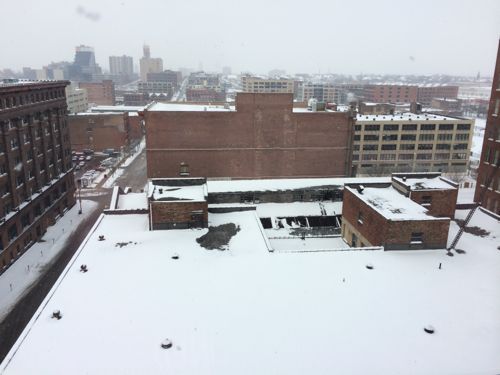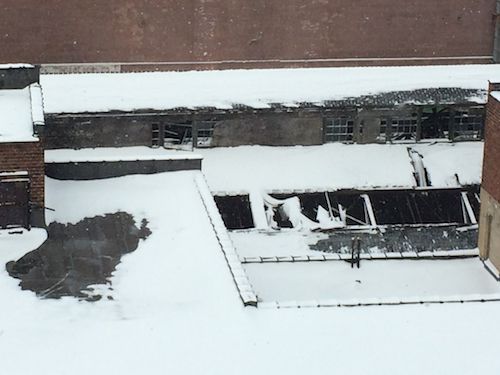Koplar Properties Allowing Historic Streetcar Power Station Roof To Cave In
The historic Cupples 7 warehouse was razed last year because owners let a small hole in the roof become a big hole over the years, destroying the structure. Last week an aerial image of similar roof damage at Lemp Brewery was posted on Facebook.
I’ve seen similar holes in the roof of the old power station on Locust, but the visible ones on the west side are nearly impossible to photograph. But yesterday I got a chance to photograph damage on the east side of the roof.



Here’s information on the building:
This tall , one story power sub station was constructed in 1903 for the St. Louis Transit Company. Stately pilasters define three bays a center bay with three segmentally arched, very narrow tall windows and bays to each side with two segmentally arched openings. Quoins and voussoirs -frame? the segment-ally arched entrance at the lower portion of the easternmost bay. A large pediment, embellished with wreath, is superimposed in front of the parapet. The west elevation is divided into 11 bays each with two segmental1y arched blind windows. (Washington Ave Historic District)
The owner is 1711 LOCUST LLC located at Maryland Plaza, Suite 300 — the offices of Koplar Properties. The last sale on city records is for $385,000 on 12/17/2007. We can’t keep letting people allow their properties fall apart while the rest of us get cited for peeling paint.
— Steve Patterson
I was cited in my conservation inspection for one of the posts on my fence in the backyard pulling away from the rest of the fence due to a tree. I couldn’t sell my house without fixing it. However, this kind of thing is allowed? Ridiculous.
Thanks for calling attention to this, Steve. Let’s see if there’s any official response from the owner, the building division, the alderman, the TV or radio news, or the mayor’s office.
While I have multiple thoughts on “preservation” and “conservation”, I’m going to limit my comments to two points on “enforcement”. One, as you point out, it’s hard to see this roof, as well as many other “flat” roofs, from the street. If we’re going to expect the city to visually inspect every roof in the city, we need to give them the tools to do so. Do we enlist the fire department to “help out”? Do we buy more “bucket” trucks for city inspectors to use? Or, do we buy drones, to fly over your, my and everyone else’s property? And how will we pay for this? Higher taxes, higher permit fees and/or higher fines?
Second, how do we gain compliance? How do we create a fine schedule that “encourages” property owners to comply with city edicts without getting to the point where recalcitrant owners either say “I’ll see you in court” or “Here, it’s yours, you fix it!” The LRA already has hundreds of properties of questionable structural integrity that they can’t (or won’t) sell, don’t maintain well, and they certainly don’t need dozens more. We’re a city with many, many old buildings, all needing ongoing maintenance. Buildings like this one end up in this condition for one of two reasons. It either becomes “too expensive” (especially when vacant) to maintain them or the owner plans to demolish the structure and sees no need to spend any more money on it. More demand would fix many of these issues – money talks.
The problem is visible from public streets/sidewalks — just not the best angles for photography.
Myself and many others have been to court over things like peeling paint. We get cited and hauled into court while others have roofs with major holes? How do we level the playing field?
The difference is that when you, I and many other owner-occupied properties get notified, we comply with the first notice, even if we think that it’s stupid or petty. The problem lies primarily with investment property owners and managers (landlords), and then, primarily, with vacant or low-income-producing properties, both commercial and residential. If there are tenants and a revenue stream, it usually makes sense to keep the property maintained and the revenue coming in.
I don’t know how long that this property has been vacant (10 years? 20? 30? more?), but at some point the likelihood of find a tenant or a buyer declines to the point where knocking it down makes more financial sense than in trying tio keep it patched up. Yes, Cannon Design took a similar building and did something wonderful with it. The trick, here, is finding someone similar, with the same vision and the same irrationally-deep pockets! Fighting citations in court, or ignoring them, is just a business decision.
Let’s talk “financial sense”:
1) the lot has only 56 foot of frontage, the land without the building isn’t in demand.
2) they paid $385,000 for it 6+ years ago, it has been vacant much longer than that.
3) Taxes on the property 2009-2013 totaled $65,144.17, no telling how much they paid in insurance.
This doesn’t make financial sense to me.
1) the land WITH the building apparently isn’t in demand, either, because . . . .
2) what sold for $385,000 in 2007 or 2008 is now listed for $245,000, a 36% reduction (and it’s still not selling)!
http://hillikercorp.com/wp-content/uploads/2013/09/1711-Locust.pdf
Odd…I find myself in agreement. Example: there are two wood, clalpboard sided, single car garages in our neighborhood. One in the middle of the block, fairly well hidden to all but the alley users. Was cited for peeling paint 3 years ago. Paint was chipping in spots but no more than what one would expect after 5 or 6 years. The other garage of same construction sits on a corner lot of one of the busy thru streets in our neighborhood, fully visible by everyone using this major street. Over 5 years ago ( could be longer…6 or 8 years, lost count) a tree limb 5″ diameter crashed onto the roof with enough force to visibly crack the roof beam. The tree limb was removed….and the garage stands years later, total roof collapse from both ends into the middle, and the side walls bowing outward. As I mentioned, the first garage is visible only to the alley users and direct neighbors. The second garage is visible to everyone that uses this major thru street. So it’s not like people don’t see it. Have the owners become insulated? Maybe don’t have the funds to repair and now remove? Have they ‘befriended’ the right people? Have the inspectors taken them to court? A hundred possible questions. Yet this eye sore is still standing….remarkably.
Than its time to start fining these holding companies for not maintain their properties. perhaps any fines collected could than be used to purchase and preserve historic properties within the city. Its a shame that so many large companies have been allowed to slide on investment properties while many homeowners have lost their homes when the expected market didn’t quite pan out. I am sure that the city could work with these owners, but things should never have gotten to the Cupples 7 level.
Most property owners don’t need the city telling them to fix a leaky roof! Any place that is owner occupied or has a tenant paying rent will fix the roof (if they can afford it) or will either have the landlord fix it or move out, to someplace that doesn’t leak. “These holding companies” either are waiting to, hopefully, find a tenant (or buyer) OR they’re waiting to tear down the building – they want the land, not the building – it’s all about revenues, both current and future. Either way, it’s a financial decision, and fines would have to be pretty steep, and likely applied to every day the violation occurs, to be effective, and then it would likely accelerate demoltion, not improve compliance! I know it sounds trite, but if you and others want to “save” multiple historic structures, it’s going to take multiple owners and tenants, like you, willing to invest the cash needed “to purchase and preserve historic properties within the city” – the city government, itself, should not be the buyer of last resort! Any city that has lost nearly 2/3 of its population is going to have buildings that are not needed and will be very difficult to “save”. What we really need is 200,000 to 300,000 people deciding to move into the city – THAT would “fix” the problem . . . .
Do-gooders and idle bloggers choose to ignore this fact.
Not every building can or should be saved. Their efforts would be better served building a time machine to go back to when streetcars ruled, we walked to grocery stores, and the car was called the horseless carriage.
Easy solution: fine them the amount it would cost the fix the damn roof. Make ’em pay one way or the other.
I don’t believe Missouri law allows this fix…. iirc actually there was an issue on the ballot not too long ago that would have increased the penalties for blight, etc. but it was defeated. Can’t remember if that was state or city ballot. Anyway, the point is that the city legally can only fine a relatively small amount and really can’t take strong action unless a public safety emergency is declared (in which case demo is usually the outcome) or if taxes are not paid.
i believe it’s the city charter that limits the fines.
Thanks, Adam, I believe that’s right. Without effective enforcement mechanisms, public awareness is particularly important. My understanding is that there are only 30 or so vacant buildings downtown now and that number continues to dwindle with continued redevelopment success and a few unfortunate losses …. seems like putting together a solid inventory and assessment of condition shouldn’t be too difficult and a good first step to being proactive. Obviously not all these buildings can be expected to come online soon, but ensuring that our best properties are protected from elements should be something that we can achieve.
I appreciate you optimism, but I see two major hurdles, especially with this structure. One, this was constructed for a very specialized use, one that doesn’t translate well to other uses. The current commercial broker has thrown out some possibilities – “Excellent Restaurant, Gallery or Event Venue Development” – and I can come up with some others – indoor climbing gym, brewery or live theater – but most of these potential users have limited financial resources to tackle a project like this one, not being major corporate users. The other challenge is simple economics – most St. Louis residents aren’t in a position to pay for someone else’s new roof along with their own. As I noted earlier, the real-world value of this structure has declined by nearly 40% in less than a decade. The owners have obviously had no luck in attracting either tenants or a buyer, so revenue has been zero (actually negative, as Steve itemized), for many years, now. Yes, a new roof could both make the building more marketable and help preserve its structural integrity, but, as with everything in life, there are no guarantees. You seem to think that “we” should (help to?) mothball every old building in hopes of finding some viable future use – I disagree. We’ve already waited several decades, if not half a century, with no apparent reuse for this “best property”. When do we say that we’ve tried our best, but enough is enough? I have no interest in using public funds when the current owner can find no financial justification for making the investment! http://en.wikipedia.org/wiki/Ghost_town
where did I say we should mothball every old building? Odd.
“Obviously not all these buildings can be expected to come online soon, but ensuring that our best properties are protected from elements should be something that we can achieve.”
you translate that into mothballing every old building? best properties does not equal all.
Obviously I didn’t understand what you wrote – by stating that “there are only 30 or so vacant buildings downtown now”, I assumed that you were trying to save all 30 . . . .
I think the easy part — because its only 30 buildings or so apparently — is doing an inventory and basic condition assessment. The hard part is figuring out what may be the best candidates for considering putting resources (and not necessarily public) into before things get into Cupples 7-type deterioration or “Most Endangered” listings. With creative thinking, surely we can protect key properties from the elements though.
Don’t worry. It only took the Koplars 30 years to do their Maryland Plaza renovation after they took it via eminent domain 30 years earlier. During those 30 years it sat vacant or vastly underused while the rest of the neighborhood thrived. They just kept saying the area just wasn’t ready for development. I am sure this area will be ready in at least another 50 years.
Has anyone heard about all the supposed environmental contamination on the inside of the building stemming from its many decades of industrial use?
Steve, this is a healthy discussion so thank you for posting. I still believe Cupples 7(?) could have been saved by installing perimeter gutters, removing the roof and installing structure 1-bay deep all the way to the former roof line. Point being: there are ways to temporarily shore up these building for better economic conditions/times. In Sam Koplar’s defense, he had the vision to TIF & dump a ton of his own family’s money into what is today a beautiful streetscape and mixed-use street (Maryland). He did this knowing full-well he’d receive a better ROI in a city with better job growth. Around this time, I was happy to see him buy 1711 Locust (I used to be a part of a group that owned 1701 Locust). For years prior to Sam’s purchase, the roof of 1711 had collapsed. I know because I almost fell through it circa 2005. As you note here, Sam purchased 2 years after I personally saw this roof already caved in. Furthermore, everyone here should note the date the purchase was made … 2007. And the price … $385,000. Then note Sovereign Partners largely control this entire block (1701 & Plaza Square, two large, vacant neighbors). Koplar received a bid to rebuild the roof for $400,000. But at some point, even a visionary that gave us a tier-one-city-street in a third tier city, cannot continue to throw good money after bad. Having said that, I believe, temporarily, it’s possible to slap 3/4-in plywood on the steel frame and staple tar paper to the plywood. But, ultimately, we need job growth (think T-Rex …). I appreciate this conversation and I hope those posting can consider we all take many risks with these buildings and no, not even the Koplar’s likely can continue to dump hundreds of thousands of dollars into property surrounded by bigger vacancy. You’d be better serving this conversation by combating misuse of TIF in the county, which creates unfair retail competition for our core (TIF was created for blighted cores not farm fields) … or by urging conservative politicians to STOP changing our historic tax credit program … or even by helping market this opportunity to a creative firm, a concert venue or even a restaurant. I know Koplar considered many options including an indoor golf facility. Then 2007 turned into 5 years of no growth. Thanks for posting. Water-proofing is key. Maybe even giant tractor truck trailer tarps could help. Tri City Canvas in Granite custom makes those. I’ve used them in the past.
Well said. And another source for “tarps” are old billboard wraps.
If anyone is curious about the inside Campbell House did a blog postingon this building.
http://campbellhousemuseum.wordpress.com/tag/1711-locust/
thanks for sharing…. it would make a great beer hall/garden even with an exposed/partially exposed roof. Maybe something called The Saint Louis Beer Guild that features local craft beers. Or a unique private venue like the old movie theater on Columbia.